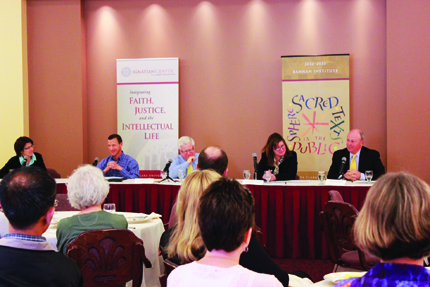
An Oddly Satisfying Sacred Text
"Go Forth and Teach: The Characteristics of Jesuit Education"
INTERNATIONAL COMMISSION ON THE APOSTOLATE OF JESUIT EDUCATION (1986)
Can a sacred text be written by committee? Can a sacred text arise during a decade known more for disco and wine coolers than religious devotion? Can a writing that consists mostly of numbered bullet points qualify as a sacred text?
I am wagering on an affirmative answer to each of those questions.
You don’t often hear anyone mention a Jesuit document called “Go Forth and Teach: The Characteristics of Jesuit Education.” I may qualify as its biggest fan, but I hope I am not the only one who appreciates its rich contribution. For my money, it deserves a much higher profile in conversations about the educational enterprise in general, and the mission of Jesuits and their colleagues, more specifically, on campuses like Santa Clara University.
The document (generally referred to simply as “Characteristics”) was published by the International Commission on the Apostolate of Jesuit Education, in 1986. That year marked the 400th anniversary of the Ratio Studiorum (1586), a landmark set of pedagogical principles that long guided the system of Jesuit education. For centuries, teachers and administrators have looked to the Ratio for practical advice as well as inspiration for their noble mission of education.
The Jesuit Father General at the time of the publication of the Characteristics, Peter- Hans Kolvenbach, explicitly noted that the 1986 document is not intended to serve as a new Ratio, but, like its predecessor, “It can give us a common mission and a common sense of purpose; it can be a standard against which we measure ourselves.”(1) Father Kolvenbach affirms in a cover letter that accompanies the document that it is intended not only for Jesuits but also for all religious and lay people who collaborate with Jesuits in educational apostolates. Further, although the Characteristics document primarily focuses on the renewal of secondary education, its content is clearly applicable for all levels of Jesuit-sponsored education.

Whether one is concerned about the success of Nativity schools, Christo Rey-style secondary education, Jesuit-sponsored high schools or colleges and universities, the document is extremely useful for the task of what we Jesuits call apostolic discernment. Just as Saint Ignatius of Loyola emphasized individual and interior spiritual discernment in his Spiritual Exercises, we who follow the Jesuit founder at a distance of five hundred years do well constantly to ask challenging questions about our collective and external activities. Are we who truly love these schools proceeding in the best possible way, with maximum effectiveness and fidelity to the mission? Are we still on the right track, or could our efforts benefit from a renewal or course adjustment? The Characteristics document is a tool that allows educators to conduct a collective institutional inventory, an examination of conscience writ large, if you will.
To help address such questions, which arise in every age and every culture where Jesuits and their colleagues educate, the document presents a series of 28 marks of Jesuit education. There is no substitute for citing this list in full:
Jesuit education . . .
- Is world-affirming
- Assists in the total formation of each individual within the human community
- Includes a religious dimension that permeates the entire education
- Is an apostolic instrument
- Promotes dialogue between faith and culture
- Insists on individual care and concern for each person
- Emphasizes activity on the part of the student in the learning process
- Encourages life long openness to growth
- Is value-oriented
- Encourages a realistic knowledge, love and acceptance of self
- Provides a realistic knowledge of the world in which we live
- Proposes Christ as the model of human life
- Provides adequate pastoral care
- Celebrates faith in personal and community prayer, worship and service
- Is preparation for active life commitment
- Serves the faith that does justice
- Seeks to form “men and women for others”
- Manifests a particular concern for the poor
- Is an apostolic instrument, in service of the church as it serves human society
- Prepares students for active participation in the Church and the local community, for the service of others
- Pursues excellence in its work of formation
- Witnesses to excellence
- Stresses lay-Jesuit collaboration
- Relies on a spirit of community among teaching staff and administrators, the Jesuit community, governing boards, parents, former students, benefactors
- Takes place within a structure that promotes community
- Adapts means and methods in order to achieve its purposes most effectively
- Is a “system” of schools with a common vision and common goals
- Assists in providing the professional training and ongoing formation that is needed, especially for teachers.
Except for twenty brief paragraphs of introductory material, a one-page conclusion, and two appendices, this list of 28 characteristics forms the skeletal outline of the entire document. The items are clustered together and amplified with a few paragraph of description relating to each.
Readers familiar with things Jesuit will have no challenge at all matching many of these 28 items to concerns expressed in the course of the history of the Society of Jesus. The promotion of dialogue between faith and culture (item 5) is a major theme of the documents that came out of General Congregation 34 in 1995. The 16th item among the Characteristics places in a nutshell the clarion call for serious attention to the relationship of faith and justice issued by General Congregation 32 in 1974–75. Pedro Arrupe, who served as General of the Society from 1965 to 1981, gets a shout-out in item 17, as he was responsible for popularizing the phrase “men and women for others.” The importance of cura personalis (care and concern for each individual, cited in item six), dating from the Jesuit Constitutions, has been a constant motif of Jesuit life and apostolic initiatives. Those who wrote this document in 1986 were by no means pretending to invent any of these themes whole-cloth, but were deliberately weaving together familiar strands to create an elegant tapestry.
Can a text that is so susceptible to charges of being derivative and unoriginal
still be considered sacred?

Can a text that is so susceptible to charges of being derivative and unoriginal still be considered sacred? My affirmative answer to this question is grounded in my strong conviction that this document is by no means a static summary of so many previous themes and imperatives, but a truly dynamic and inspiring agenda for ongoing improvement. Consider,for example, item 18. Sure, it is easy to give perfunctory assent to the principle that Jesuit education should be particularly concernedfor the poor, but take a moment to ponder what that might mean in various corners of the world today and what a huge challenge this commitment amounts to. Will Jesuit provinces in rich and poor countries alike steward their precious resources in the quite risky ways that will be required to increase access of low-income people to Jesuit education? Will the Jesuits in the United States, as just one example, continue to experiment creatively with new delivery models (such as the Cristo Rey and Nativity schools), even if this means forgoing further commitments of manpower and energy to more traditional schools that tend to serve the more affluent sectors of society? How should we think about priorities and opportunity costs?
A quarter-century now after its publication, the Characteristics document remains a source of inspiration because it continues to address and open up pivotal questions like these. Making a valiant stand against any temptation to cut corners or settle into apathy, this document reminds its readers, Jesuit educators and many others as well, of our common rootednessin a long and living tradition of educational excellence. Reinforcing this illuminating linkage of past and future, its two appendices make an effort to describe the distinctive Ignatian worldview and spiritual vision that is reflected in the 28 characteristics.
In my judgment, what makes this document sacred, rather than merely useful, is its implicit awareness that excellent education in the Jesuit tradition is not merely an achievement, but ultimately a process—an open-ended and never completed quest to live out the full potential of what we have inherited. The document begs to be engaged in a critical way and updated for new times and in the full range of cultures where Jesuit education finds itself. It has certainly helped ground my work in the past 25 years in Jesuit high schools, colleges, and particularly in two graduate theology centers.
The Characteristics document remains one of the great treasures of the Jesuit tradition that I am proud to share with all my colleagues and the publics with which I work.
Not bad at all for a bullet-pointed committee document.
THOMAS MASSARO, S.J., is Dean of the Jesuit School of Theology of Santa Clara University. A member of the New England Province of the Society of Jesus, he holds a doctorate in Christian social ethics from Emory University and taught Moral Theology for 15 years at the Boston College School of Theology and Ministry and its predecessor, Weston Jesuit School of Theologyin Cambridge. He has published numerous articles and seven books, including three editions of the popular classroom text Living Justice: Catholic Social Teaching in Action.
Endnotes
- Peter Hans Kolvenbach, “Letter to All Major Superiors,”(Rome) 8 December 1986. This quotation comes from Kolvenbach’s letter accompanying “The Characteristics of Jesuit Education.” (1986).